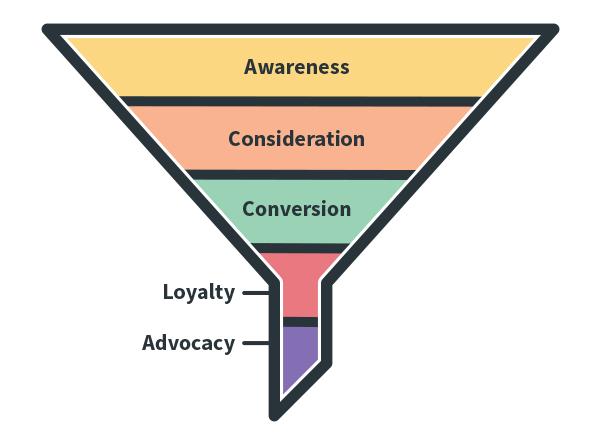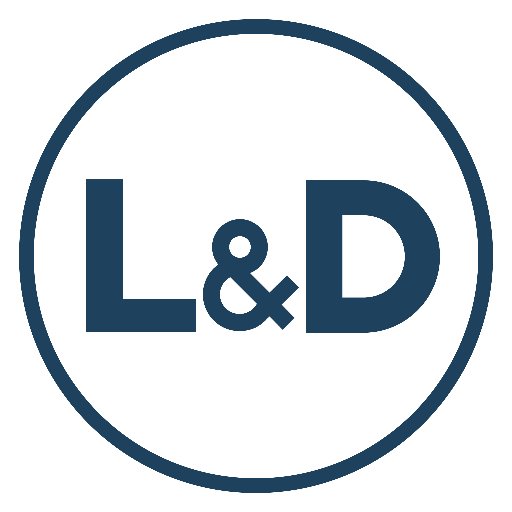Using a Marketing Funnel to Improve the Learning Experience
Marketers use a funnel to help them visualize the buyer’s journey or the path a prospect takes from discovering their company all the way to purchasing a product or service and beyond. The funnel allows them to write content that aligns with every step of this journey and predict the buyer’s needs along the way. L&D professionals can use this idea of a funnel to take a look at the employee lifecycle and develop a content strategy that aligns with their needs.

The Marketing Funnel
The marketing funnel is a tool consisting of multiple stages, starting with the introduction of a product or service and continuing to conversion and beyond. A prospect moves from one stage to the next as interest in a product increases or exits the funnel if he or she is no longer considering a product. The top of the funnel is always wider as there are more prospects who are interested in the product than there are prospects who want to purchase it. The marketing funnel consists of five stages:
- Awareness: Prospects learn who you are.
- Consideration: Prospects are willing to consider your company.
- Conversion: You convince prospects to purchase a product.
- Loyalty: You retain customers.
- Advocacy: You turn customers into fans.

Marketers understand that prospects have different content needs based on the stage they are in, and they move prospects along the funnel by offering specific and personalized content that aligns with that stage. For example, in the awareness stage, marketers educate prospective customers about their products in order to show its value. Prospects don’t know about the value of a product at this stage and won’t be engaged by sales-heavy content. In this stage, marketers often use educational blog posts or e-books to position the company as a thought leader.
Leveraging a Marketing Funnel in L&D
L&D professionals often conduct a quick needs analysis before starting to create content, but often, they do not consider the stages of the learner lifecycle or the kind of content that really spikes learners’ interest. Most likely, learners won’t exit a learning initiative before the training is over, and the L&D funnel has the same width regardless of the stage. Learners can, however, lose interest throughout training, which L&D professionals should certainly consider from an engagement perspective and build into their funnel.
One way to leverage the marketing funnel approach is to build different pieces of content for one learning initiative, starting with making the learner aware of the training and ending with implementing the newly learned content at work (conversion). Let’s say, for example, you are tasked with rebuilding health and safety training at your company. Instead of assigning three e-learning modules to everyone, you could create a short video that sparks interest in the topic. This awareness stage is the first step in the funnel for the learner.
In the consideration stage, you might want to create some personalized training that aligns with the learner’s job role and how health and safety affects it. There is no need to create one piece of content for every job role; focus on departments instead. The content could be in form of a webpage or an email that uses dynamic content, which displays something different based on the email recipient’s role. You only have to create the framework of the landing page or email once and add the different content pieces into the dynamic fields. Talk to your marketing department; they will be able to help.
In the conversion phase, make your learners true believers in health and safety. You could produce a live webinar, followed up by an open online chat where everyone can share their thoughts, ask questions, and even make suggestions on how to improve health and safety or for further training initiatives. This activity will help you turn some of your learners into health and safety advocates.
Along each stage, you can collect data, such as video views, video drop-off rate, click-through rates in emails or heatmaps for landing pages, live webinar attendance, and engagement throughout the webinar (chat participation, questions asked, suggestions made, etc.). These data points will show your stakeholders that employees have participated in health and safety training and give you valuable insights into learner engagement and content usability.
Developing an Engaging Content Strategy
No matter the topic of your training initiative, the main focus for using a marketing funnel in L&D is a solid content strategy that aligns with learners’ needs. Go beyond a basic needs analysis, and establish what content should be delivered and when and where to deliver it. Often, we forget about how learners want to access content and we focus too much on creating a “shiny object.” Leverage data throughout the process to better understand what really excites and engages your learners, and use that data to improve your learning offerings in real time.
Thinking about a learner funnel will allow you to improve not only your learning experiences but also collect data along the way and create an engaged workforce who will understand the importance of the content you deliver to them.
Source: Bianca Baumann on Training Industry, CTDP, director of learning experience design at GP Strategies Canada, focuses on digital education success, combining L&D, marketing and customer success to create outstanding learning experiences that stick.
- 7 chiến lược giúp quản lý đồng nghiệp cũ khi bạn trở thành sếp
- Cảm ơn các giảng viên đã đồng hành cùng chúng tôi trên hành trình học tập một năm qua!
- TalentPool đồng hành cùng TÀI NĂNG LÃNH ĐẠO "Táo bạo để vươn xa"
- Sinh viên thế kỉ 21 muốn thành công chắc chắn phải có kĩ năng làm việc chuyên nghiệp
- Khởi động dự án Xây dựng khung năng lực đào tạo cùng EVN CPC
CERTIFICATIONS FOR TRAINING PROFESSIONALS
Most certification eligibility requirements include several years of experience in a performance improvement and facilitating field.
The following table provides a list of some of the most recognized certifications for training professionals

The 7 Types Of Power That Shape The Workplace
Power comes in many different forms, and leaders need to learn how to handle each type.
"Power tends to get to people's heads," psychologist Nicole Lipkin tells Business Insider. "We're not really trained to handle power well."

TAKE THE MYSTERY OUT OF MARKETING YOUR LEARNING FUNCTION
You already have all it takes to be a great marketer of training. You just need to fine-tune your focus on knowing your audience and building relationships throughout your organization.
Article Author:
By Melissa Smith and Maria Chilcote, Managing Partners, The Training Clinic
Marketing is one of those business skills that appear to have eluded many of us in the Learning and Development (L&D) field.
